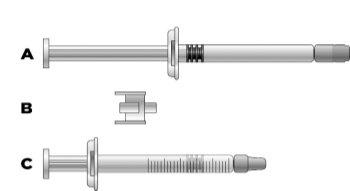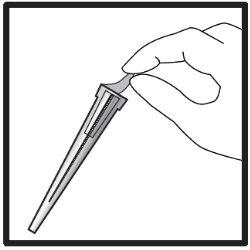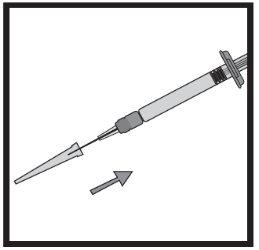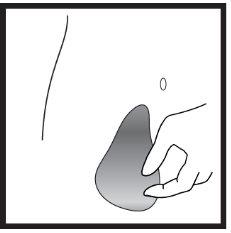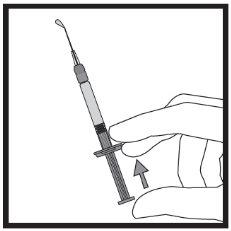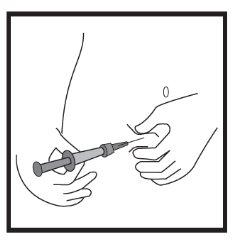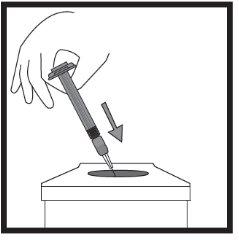

ІКАТІБАНТО СТАДА 30 мг розчин для ін'єкцій у попередньо заповненому шприці

Запитайте лікаря про рецепт на ІКАТІБАНТО СТАДА 30 мг розчин для ін'єкцій у попередньо заповненому шприці

Інструкція із застосування ІКАТІБАНТО СТАДА 30 мг розчин для ін'єкцій у попередньо заповненому шприці
Вступ
Опис: інформація для користувача
Ікатібант Стада 30 мг розчин для ін'єкцій у попередньо заповненому шприці EFG
Перш ніж почати використовувати цей лікарський засіб, уважно прочитайте весь опис, оскільки він містить важливу інформацію для вас.
- Збережіть цей опис, оскільки вам може знадобитися знову його прочитати.
- Якщо у вас виникли питання, проконсультуйтеся з вашим лікарем або фармацевтом.
- Цей лікарський засіб призначений лише для вас і не слід давати його іншим людям, навіть якщо вони мають相同ні симптоми, оскільки це може їм зашкодити.
- Якщо ви відчуваєте побічні ефекти, проконсультуйтеся з вашим лікарем або фармацевтом, навіть якщо це побічні ефекти, які не вказані в цьому описі. Див. розділ 4.
про побічні ефекти, які не вказані в цьому описі. Див. розділ 4.
Зміст опису
- Що таке Ікатібант Стада і для чого він використовується
- Що потрібно знати перед початком використання Ікатібанту Стада
- Як використовувати Ікатібант Стада
- Можливі побічні ефекти
- Зберігання Ікатібанту Стада
- Зміст упаковки та додаткова інформація
1. Що таке Ікатібант Стада і для чого він використовується
Ікатібант Стада містить активну речовину ікатібант.
Цей лікарський засіб використовується для лікування симптомів спадкового ангіоедему (СА) у дорослих, підлітків і дітей старше 2 років.
При СА збільшуються концентрації речовини, присутньої в крові, званої брадикініном, що призводить до симптомів, таких як набряк, біль, нудота і діарея.
Ікатібант блокує дію брадикініну і, таким чином, гальмує розвиток симптомів кризи СА.
2. Що потрібно знати перед початком використання Ікатібанту Стада
Не використовуйте Ікатібант Стада
- якщо ви алергічні на ікатібант або на будь-який інший компонент цього лікарського засобу (перелічені в розділі 6).
Попередження та обережність
Проконсультуйтеся з вашим лікарем перед початком використання ікатібанту:
- Якщо ви страждаєте на стенокардію (зменшення кровотоку, який надходить до серця).
- Якщо ви недавно перенесли інсульт.
Побічні ефекти, пов'язані з ікатібантом, подібні до симптомів вашої власної хвороби. Негайно проконсультуйтеся з вашим лікарем, якщо ви помітите, що симптоми кризи погіршуються після введення ікатібанту.
Крім того:
- Ви або ваш опікун повинні вивчити техніку введення підшкірних ін'єкцій (під шкіру) перед тим, як самостійно або ваш опікун введе цей лікарський засіб.
- Негайно після самостійного введення ікатібанту або після введення його вашим опікуном під час кризи ларінгеальної обструкції (закриття верхніх дихальних шляхів), ви повинні звернутися за медичною допомогою до медичного закладу.
- Якщо ваші симптоми не покращуються після самостійного введення ікатібанту або після введення його вашим опікуном, ви повинні проконсультуватися з лікарем про введення додаткових ін'єкцій цього лікарського засобу. У дорослих пацієнтів можна вводити до 2 додаткових ін'єкцій протягом 24 годин.
Діти та підлітки
Не рекомендується цей лікарський засіб для дітей молодше 2 років або тих, хто важить менше 12 кг, оскільки він не вивчався у цих пацієнтів.
Інші лікарські засоби та Ікатібант Стада
Повідомте вашому лікареві, якщо ви приймаєте, недавно приймали або можете приймати будь-який інший лікарський засіб.
Не відомі взаємодії ікатібанту з іншими лікарськими засобами. Якщо ви приймаєте будь-який лікарський засіб, який є інгібітором ангіотензинперетворюючого ферменту (АПФ) (наприклад, каптоприл, еналаприл, рамиприл, хінаприл, лізиноприл) для зниження артеріального тиску або з будь-якої іншої причини, повідомте вашому лікареві перед тим, як використовувати цей лікарський засіб.
Вагітність і лактація
Якщо ви вагітні або перебуваєте в період лактації, вважаєте, що можете бути вагітною або плануєте завагітніти, проконсультуйтеся з вашим лікарем перед тим, як почати використовувати ікатібант.
Якщо ви перебуваєте в період лактації, не слід годувати вашу дитину протягом 12 годин після останнього введення ікатібанту.
Водіння транспортних засобів та використання машин
Не водьте транспортні засоби та не користуйтеся машинами, якщо ви відчуваєте себе втомленими або заплутаними внаслідок кризи СА або після використання ікатібанту.
Ікатібант Стада містить натрій
Цей лікарський засіб містить менше 23 мг натрію (1 ммоль) на дозу; це означає, що він практично не містить натрію.
3. Як використовувати Ікатібант Стада
Слідуйте точно інструкціям щодо введення цього лікарського засобу, вказаним вашим лікарем. У разі сумнівів проконсультуйтеся з вашим лікарем знову.
Якщо ви ніколи раніше не вводили ікатібант, перша доза завжди повинна бути введена медичним працівником або працівником служби охорони здоров'я. Лікар дозволить вам вийти з лікарні, коли вважатиме, що це безпечно.
Після обговорення з вашим лікарем або медсестрою та після вивчення техніки підшкірних ін'єкцій (під шкіру) ви самі або ваш опікун можете вводити цей лікарський засіб, якщо у вас виникла криза СА.
Важливо вводити ікатібант підшкірно (під шкіру) якомога швидше після виявлення кризи ангіоедему. Медичний персонал навчить вас і вашого опікуна безпечному введенню цього лікарського засобу згідно з інструкціями опису.
Коли та з якою частотою слід використовувати Ікатібант Стада?
Ваш лікар визначив точну дозу цього лікарського засобу та скаже, з якою частотою його слід використовувати.
Дорослі
- Рекомендована доза ікатібанту становить одну ін'єкцію (3 мл, 30 мг), введену підшкірно (під шкіру) якомога швидше після виявлення кризи ангіоедему (наприклад, з збільшенням набряку шкіри, особливо на обличчі та шиї, або збільшенням абдомінального болю).
- Якщо ви не відчуваєте покращення симптомів, після шести годин запитайте у вашого лікаря про введення додаткових ін'єкцій ікатібанту. У дорослих пацієнтів можна вводити до 2 додаткових ін'єкцій протягом 24 годин.
- Не слід вводити більше 3 ін'єкцій протягом 24 годин, і якщо вам потрібно більше 8 ін'єкцій протягом місяця, запитайте у вашого лікаря.
Діти та підлітки від 2 до 17 років
- Рекомендована доза ікатібанту становить одну ін'єкцію від 1 мл до максимальної дози 3 мл залежно від ваги тіла, введену підшкірно (під шкіру) якомога швидше після виявлення симптомів кризи ангіоедему (наприклад, збільшення набряку шкіри, особливо на обличчі та шиї, або збільшення абдомінального болю).
- Проконсультуйтеся з розділом інструкцій щодо використання, щоб дізнатися, яку дозу слід вводити.
- Якщо ви не впевнені щодо дози, яку слід вводити, проконсультуйтеся з вашим лікарем, фармацевтом або медсестрою.
- Якщо ваші симптоми погіршуються або не покращуються, негайно проконсультуйтеся з вашим лікарем.
Форма введення
Ікатібант вводиться підшкірно (під шкіру). Використовуйте кожен шприц лише один раз.
Цей лікарський засіб вводиться за допомогою короткої голки в жирову тканину, розташовану під шкірою живота (черевної порожнини).
Якщо у вас є будь-які інші питання щодо використання цього лікарського засобу, проконсультуйтеся з вашим лікарем або фармацевтом.
Наступні інструкції крок за кроком передбачені для:
- самовведення (дорослі)
- введення опікуном або медичним працівником для дорослих, підлітків або дітей старше 2 років (що важать 12 кг або більше).
Інструкції включають наступні основні кроки:
- Загальна інформація
2а) Підготовка шприца для дітей та підлітків (2-17 років) вагою 65 кг або менше
2б) Підготовка шприца та голки для ін'єкції (всі пацієнти)
- Підготовка місця ін'єкції
- Введення розчину
- Видалення матеріалів ін'єкції
Інструкції крок за кроком для ін'єкції
|
|
2а) Підготовка шприца для дітей та підлітків (2-17 років) вагою 65 кг або менше: |
Важлива інформація для медичних працівників та опікунів: Коли доза нижча за 30 мг (3 мл), необхідне наступне обладнання для видалення відповідної дози (див. інформацію нижче):
|
Об'єм ін'єкції, необхідний у мл, повинен бути підготовлений у градуйованому шприці об'ємом 3 мл (див. таблицю нижче). Таблиця 1: Послідовність дозування для дітей та підлітків
Пацієнти, які важать більше 65 кг, будуть використовувати весь вміст попередньо заповненого шприца (3 мл). Якщо ви не впевнені щодо об'єму розчину, який слід видалити, проконсультуйтеся з вашим лікарем, фармацевтом або медсестрою
Уникайте дотику до кінців конектора та голок, щоб запобігти забрудненню
Перенесення розчину ікатібанту до градуйованого шприца:
|
|
Якщо в градуйованому шприці є повітря:
|
|
2б) Підготовка шприца та голки для ін'єкції: Усі пацієнти (дорослі, підлітки та діти) |
|
|
|
|
|
|
|
|
|
4. Можливі побічні ефекти
Як і всі лікарські засоби, цей лікарський засіб може викликати побічні ефекти, хоча не всі люди їх відчувають. Практично всі пацієнти, які приймають ікатібант, відчувають реакцію в місці ін'єкції (таку як подразнення шкіри, запалення, біль, свербіж, червоність шкіри та печіння). Ці ефекти зазвичай є легкими та покращують без потреби будь-якого додаткового лікування.
Повідомте вашому лікареві негайно, якщо ви помітите, що симптоми кризи погіршуються після введення ікатібанту.
Дуже часті(можуть впливати на більше 1 з 10 осіб):
Додаткові реакції в місці ін'єкції (чуття тиску, синяк, зниження чутливості та/або оніміння, збільшення висипання на шкірі з свербінням та жаром).
Часті(можуть впливати до 1 з 10 осіб):
Нудота
Головний біль
Запаморочення
Лихорадка
Свербіж
Висипання
Червоність шкіри
Аномальні тести функції печінки
Частота невідома(не може бути оцінена на основі доступних даних):
Кропив'янка (уртикарія)
Звіт про побічні ефекти
Якщо ви відчуваєте будь-який побічний ефект, повідомте вашому лікареві або фармацевту, навіть якщо це можливі побічні ефекти, які не вказані в цьому описі. Ви також можете повідомити про них безпосередньо через систему моніторингу безпеки лікарських засобів для людини: https://www.notificaram.es. Надсилаючи повідомлення про побічні ефекти, ви можете допомогти надати більше інформації про безпеку цього лікарського засобу.
5. Зберігання Ікатібанту Стада
Тримайте цей лікарський засіб поза зоною досяжності дітей.
Не використовуйте цей лікарський засіб після закінчення терміну придатності, вказаного на етикетці та упаковці після "CAD". Термін придатності - останній день місяця, який вказано.
Не зберігайте при температурі вище 25°C. Не заморожуйте.
Не використовуйте цей лікарський засіб, якщо ви помітите, що упаковка шприца або голки пошкоджена або якщо ви помітите видимі ознаки псування; наприклад, якщо розчин є мутним, містить плаваючі частинки або якщо колір розчину змінився.
Лікарські засоби не слід викидати в каналізацію або сміття. Спитайте у вашого фармацевта, як видалити упаковку та лікарські засоби, які вам більше не потрібні. Таким чином, ви допоможете захистити навколишнє середовище.
6. Зміст упаковки та додаткова інформація
Склад Ікатібанту Стада
- Активний інгредієнт - ікатібант. Кожна предварительно наповнена шприц містить 30 міліграмів ікатібанту (у вигляді ацетату ікатібанту). Кожний мл розчину містить 10 мг ікатібанту.
- Інші компоненти: хлорид натрію, оцтовий кислотний глей, гідроксид натрію (для регулювання pH) та вода для ін'єкційних препаратів.
Вигляд Ікатібанту Стада та зміст упаковки
Ікатібант представлений у вигляді прозорої та безбарвної ін'єкційної розчину у скляній предварительно наповненій шприці об'ємом 3 мл. Упаковка містить гіподермічну голку.
Ікатібант доступний у одиницевій упаковці з однією предварительно наповненою шприцем та голкою або у багатій упаковці з трьома предварительно наповненими шприцами та трьома голками.
Можливо, що тільки деякі розміри упаковок будуть реалізовані.
Власник дозволу на реалізацію та відповідальна особа за виробництво
Власник дозволу на реалізацію
Лабораторія Стада, С.Л.
вул. Фредеріка Момпу, 5
08960 Сант-Жуст-Десверн (Барселона)
Іспанія
Відповідальна особа за виробництво
Pharmadox Healthcare Ltd.,
KW20A Kordin Industrial Park,
Паола PLA 3000
Мальта
або
STADA Arzneimittel GmbH
Мутгассе 36/2 1190 Відень,
Австрія
або
STADA Arzneimittel AG
Стадаштрассе 2 – 18
61118 Бад-Вільбель
Німеччина
або
Eurofins PROXY Laboratories (PRX)
Архімедесвег 25 2333 CM Лейден
Нідерланди
Дата останнього перегляду цього проспекту:Вересень 2021
Детальна та актуальна інформація про цей лікарський засіб доступна на сайті Іспанського агентства лікарських засобів та медичних продуктів (AEMPS) http://www.aemps.gob.es/
- Країна реєстрації
- Діючі речовини
- Потрібен рецептТак
- Виробник
- Інформація є довідковою і не є медичною порадою. Перед прийомом будь-яких препаратів обов'язково проконсультуйтеся з лікарем. Oladoctor не несе відповідальності за медичні рішення, прийняті на основі цього контенту.
- Альтернативи до ІКАТІБАНТО СТАДА 30 мг розчин для ін'єкцій у попередньо заповненому шприціФорма випуску: РОЗЧИН ДЛЯ ІН'ЄКЦІЙ, 30 мгДіючі речовини: icatibantПотрібен рецептФорма випуску: РОЗЧИН ДЛЯ ІН'ЄКЦІЙ, 30 мгДіючі речовини: icatibantВиробник: Accord Healthcare S.L.U.Потрібен рецептФорма випуску: РОЗЧИН ДЛЯ ІН'ЄКЦІЙ, 30 мгДіючі речовини: icatibantВиробник: Laboratoire AguettantПотрібен рецепт
Аналоги ІКАТІБАНТО СТАДА 30 мг розчин для ін'єкцій у попередньо заповненому шприці в інших країнах
Найкращі аналоги з тією самою діючою речовиною та терапевтичним ефектом.
Аналог ІКАТІБАНТО СТАДА 30 мг розчин для ін'єкцій у попередньо заповненому шприці у Polonia
Аналог ІКАТІБАНТО СТАДА 30 мг розчин для ін'єкцій у попередньо заповненому шприці у Ucrania
Лікарі онлайн щодо ІКАТІБАНТО СТАДА 30 мг розчин для ін'єкцій у попередньо заповненому шприці
Консультація щодо дозування, побічних ефектів, взаємодій, протипоказань та поновлення рецепта на ІКАТІБАНТО СТАДА 30 мг розчин для ін'єкцій у попередньо заповненому шприці – за рішенням лікаря та згідно з місцевими правилами.




